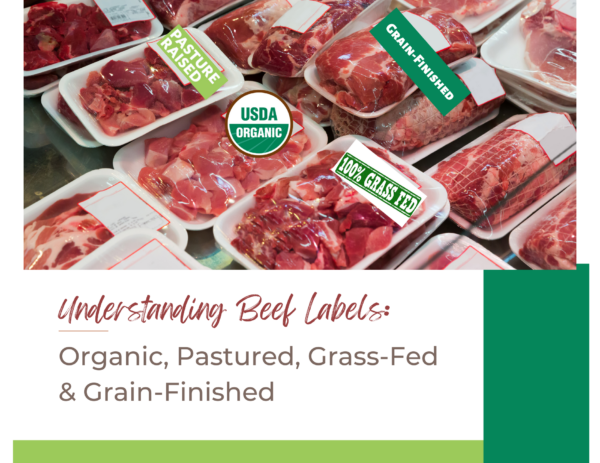
Ten years ago, when you went to the supermarket, beef was pretty much labeled as “beef.” Now it practically feels as if you need a Ph.D in Nutrition just to go to the grocery store. These days you can find all sorts of terminology on beef: natural, organic, grass-fed, pastured, grain-finished…
Confused yet?
Here is a quick overview of what each of these beef labels means. Then we will get into which beef is best to buy.
Conventional or No Label
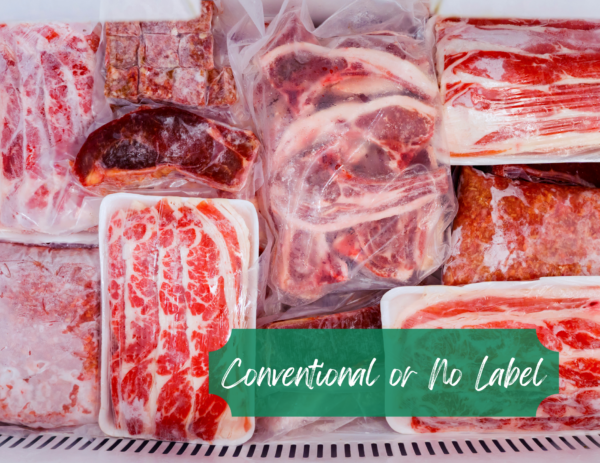
If the beef doesn’t carry any special label, then it almost certainly was raised on a feedlot eating grains. We will get into why this is bad later.
Natural
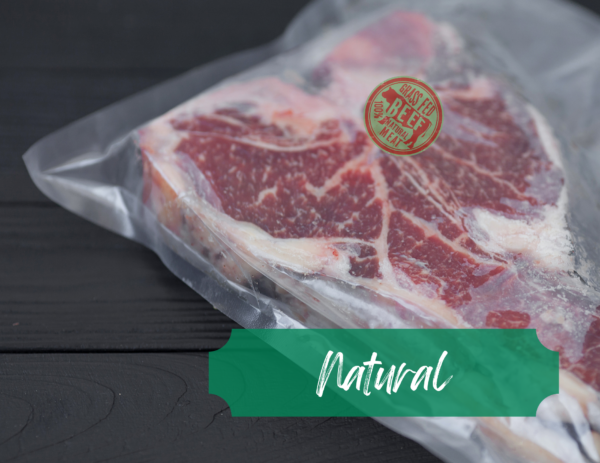
This label is pretty much meaningless as almost anyone can slap “natural” on the meat label – even if the meat was produced in really unnatural conditions. Natural meat cannot, however, contain artificial ingredients, coloring, or preservatives. Pretty much all fresh meat qualifies as “natural.”
Organic
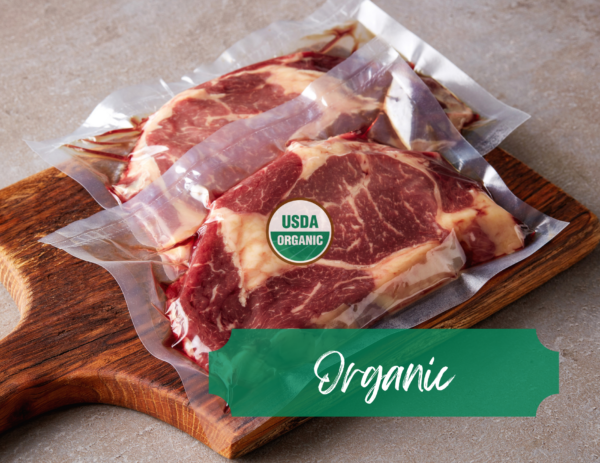
Beef which carries the organic label is born and raised on organic pasture, must be fed only organic grass or grains, cannot be given any hormones or antibiotics, and must have unrestricted access to organic pasture.
Grass-Fed or Grass-Finished
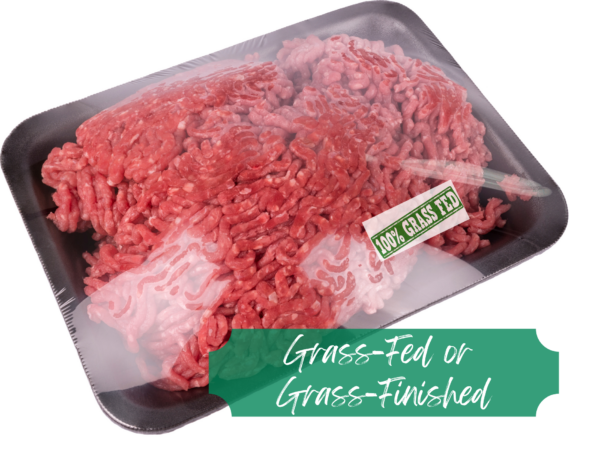
This beef is from cows who only ate grass for their entire lives (except when they were drinking milk). Grass-fed beef can contain hormones and antibiotics. Also, grass-fed beef is not necessarily the same as pasture-raised beef since the cows could have been given hay while confined to a pen.
Pastured or Pasture Raised
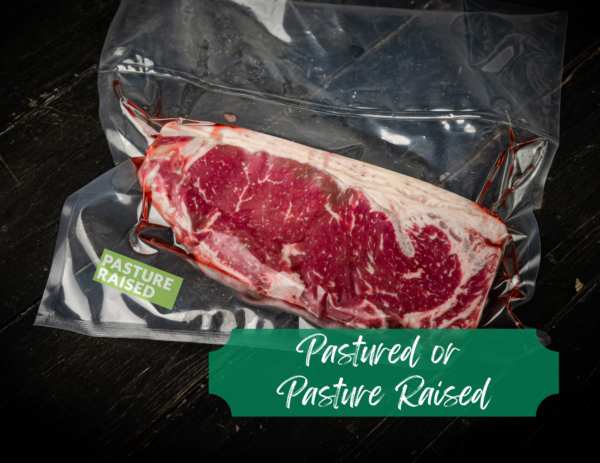
These cows were raised on a pasture, which means they were probably eating mostly grass, but could have been given grains as well (such as during winter or if the pasture doesn’t have enough grass). There is still no legal definition for pastured, so don’t assume that pastured meat comes from cows which lived happily on a pasture! They might have been on the pasture just for a short part of their lives.
Grain-Finished
Keep in mind that most cows consume grass on a pasture for the first few months of their lives. Then they are sent to feedlots where they are fattened up. So, the “grain-finished” label is pretty much the same thing as conventional beef. You usually find the grain-finished label with some other label, like “Organic Grain-Finished Beef” so you know the animals were pastured and then given organic grains for the last 2-3 months of their lives.
Why Avoid Conventional CAFO Beef
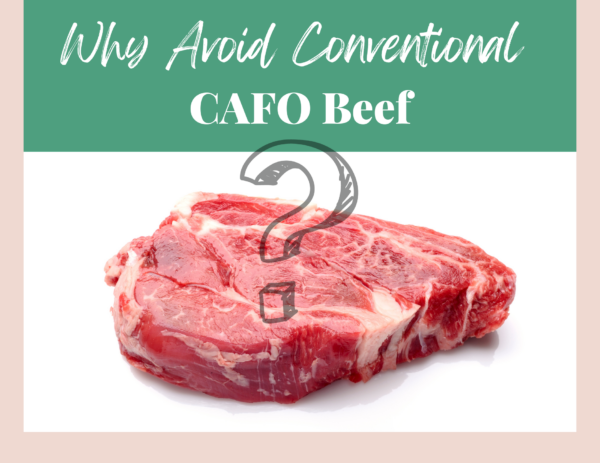
If you can afford it, then you should definitely avoid eating conventional CAFO beef (CAFO = Concentrated Animal Farming Organization aka feedlot). Even if you think you can’t afford it, you should still try to make room in your budget! The benefits of choosing quality meat are worth the extra expense.
Antibiotics in Conventional Beef
Aside from the moral issues of eating meat which was raised on a factory farm, there are a lot of health issues to consider. For starters, there are all the antibiotics which feedlot cows receive. This is because the living conditions on feedlots are so terrible that the cows are routinely medicines given to prevent disease. The antibiotics also cause the animals to gain weight, so they’ve been routinely given to cows for the past 30 years or so. These antibiotic are present in the meat, and get into our bodies. This has led to many strains of bacteria becoming resistant to bacteria.
Here is a scary fact about antibiotics in meat: a 2001 study found that 20% of ground meat in supermarkets contained salmonella. Of that 20%, 84 percent was resistant to at least one form of antibiotic. In a nutshell, the antibiotics are causing super-bacteria to grow in the meat (including E. Coli), and those super-bacteria are now resistant to antibiotics.
Hormones in Conventional Beef
Then there is the issue of hormones in meat. We’ve all heard a lot about recombinant Bovine Growth Hormone (rBGH) but this is just one hormone that gets into our bodies from meat. Others include testosterone, progesterone, and various anabolic steroids. These hormones have been linked to numerous cancers, developmental problems, low sperm count, and early puberty, among other problems. (Hint: if we keep this up, we’ll be getting our daughters fitted for bras in kindergarten).
Chemicals in Conventional Beef
Along with the antibiotics and hormones in conventional CAFO beef, you could have any number of harmful chemicals. These chemicals come from pesticides and herbicides on the grains they are fed, anti-parasite drugs, and maybe even a concoction which is injected into the meat to make it stay red and juicy-looking longer. Then there are all the issues associated with eating GMO-foods, and you can bet that those cows were eating GMO (genetically modified) corn!
Problems with Feeding Cows Grain
I’m not going to get into this one too much because some authorities have already done a good job of covering why grass-fed beats grain-fed (like this article from Food Revolution). In a nutshell, cows were NOT meant to eat grains. They have four stomachs to help them break down the cellulose in grass and convert it into energy and body mass (i.e. meat for us). However, because of subsidies for corn, farmers started giving corn to their cows instead of letting them roam and eat grass. The cows get a lot fatter on a grain-fed diet, and they get fatter faster, which means more profits for the farmers. Cows cannot digest grains and convert them to protein (meat) efficiently. When given grains, they experience severe problems like bloat. Bloat doesn’t sound terrible, but it can actually kill the cows. Since their immune systems are so shot from eating grains, getting meat from CAFO animals “would be impossible if it weren’t for the routine and continual feeding of antibiotics.”
What Beef is Best?
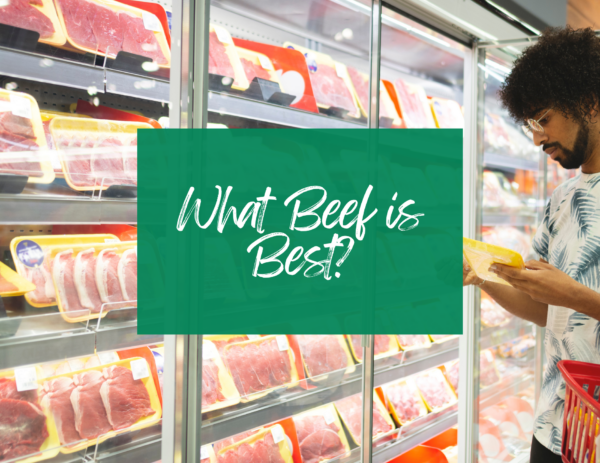
The best thing you can buy is organic, pasture-raised, grass-fed beef. You ideally should have all three labels because organic doesn’t ensure the animals are eating grass (they could be on an all-grain diet). Pasture-raised doesn’t ensure that the animals are only eating grass (they can be supplemented with grain) or that they aren’t given any antibiotics or hormones. And grass-fed also doesn’t ensure the animals aren’t given any antibiotics or hormones, or that they are living in a pasture (they can be given hay indoors).
Here’s the problem: I don’t think I have ever seen beef which contains all 3 labels. It is probably near impossible for farmers to get all of these labels, all of the time. So, skip the “pasture” label. It isn’t regulated by the USDA anyway and realistically farmers can’t pasture their animals in winter.
Organic, grass-fed beef is more expensive than conventional beef. But it is worth the extra expense, and not just because of animal welfare. Beef produced in these ways is much, much healthier!!
For starters, choosing organic means you are avoiding the scary hormones, antibiotics, GMOs, and chemicals which get into the meat. Secondly, there are numerous proven health benefits of eating grass-fed meat instead of grain-fed meat.
Health Benefits of Grass-Fed Beef
Here are just some of the ways that grass-fed beef is superior to grain-fed beef:
- Calories: Grass-fed beef has less fat than grain-fed beef, which means you get fewer calories. In a 3-oz serving of grass-fed beef, you can have up to 45 fewer calories.
- Omega 3 and Omega 6 Fatty Acids: Grass-fed beef has much more healthy Omega 3 fatty acids and less unhealthy Omega 6 fatty acid than grain-fed beef. According to Chris Kresser, the average ratio of Omega 6 to Omega 3 in grass-fed beef is 1.53 to 1. In grain-fed beef, the ratio is 7.65 to 1! (remember, you want more Omega 3 and less Omega 6)
- Vitamins, Minerals, and Antioxidants: Grass-fed beef has higher levels of certain nutrients, especially vitamin E and beta carotene (which is why grass-fed beef will have more of a yellowish color than grass-fed beef).
Where to Buy Beef
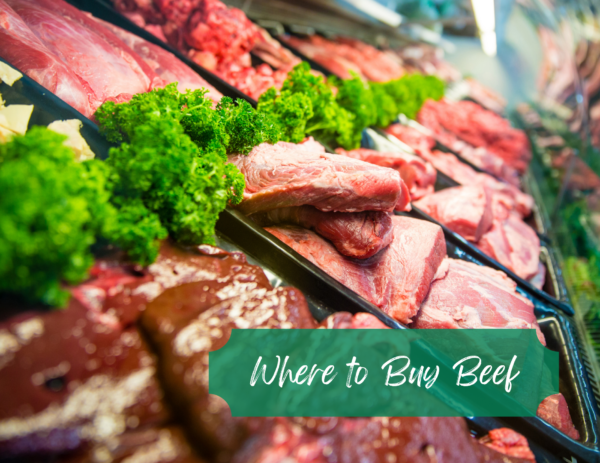
When I was living in Los Angeles (we’ve recently moved to Abu Dhabi), we bought our meat from a local farmer. It is cheaper, you support small farmers, and you know exactly where your meat is coming from. Check and see if you have any organic farmers around you raising pastured, grass-fed beef. If they are far away, then you can do what we did: buy an extra freezer. Then you can just buy a whole cow (literally) and put portions into the freezer.
You can now usually find organic, grass-fed beef in health food stores and supermarkets! Some of my favorite places to shop include:
- Whole Foods.
- Amazon
- US Wellness Meats
Need help making the best food choices when at the supermarket or dining out? You need The Renegade Guide to Dining Out. Written by Kristin Michaelis, it tells you exactly how to prioritize food choices and even has cheat sheets. You can read my review here or get your copy here.

Resources for this article:
http://chriskresser.com/why-grass-fed-trumps-grain-fed
http://www.simpletruth.com/community/blog/making-the-switch-to-grass-fed-beef/
http://www.motherearthnews.com/homesteading-and-livestock/usda-grass-fed-label-zmaz08amzmcc.aspx#axzz3HMI2ZnX0
http://www.pbs.org/wgbh/pages/frontline/shows/meat/safe/overview.html
http://www.organicconsumers.org/articles/article_5543.cfm
http://www.health.com/health/article/0,,20458816_3,00.html
http://www.sustainabletable.org/258/hormones
http://www.motherearthnews.com/homesteading-and-livestock/beef-industry-zmaz08fmzmcc.aspx#axzz3HMI2ZnX0
Latest posts by Sylvie McCracken (see all)
- Treating H. Pylori (Part 3): What H. Pylori Does to the Body - August 8, 2022
- Treating H. Pylori (Part 2): How H. Pylori is Contracted - August 3, 2022
- Understanding Beef Labels: Organic, Pastured, Grass-Fed & Grain-Finished - July 25, 2022